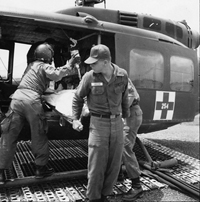The Beginning


Wounded American Marine rests as he is evacuated from a battle zone near Gia Binh, South Vietnam.
(Barry & Margaret Zorthian Collection [VA052965])
In April of 1962, the 57th Medical Detachment (Helicopter Ambulance) arrived in Vietnam with five UH-1 "Huey" helicopters. The 57th, the original Dustoff unit, served in Vietnam for eleven years. In the beginning they had to deal with equipment shortages, supply issues and the logistics of setting up a helicopter evacuation system for the entire country. The early Dustoff commanders knew that they needed to solidify the mission of the company if they were to succeed. Were they only to evacuate wounded? Could they transport dead? Could they transport troops and weapons to the locations that they were traveling to? The situation was unsure at first, but the early commanders fought vehemently to keep their mission the same: evacuate the wounded. A job that the pilots and crew managed with great skill and daring over the course of the war.

In a secured area on the outskirts of Saigon, medics and members of an Aviation Medical Evacuation Unit practice airlifting a soldier from the ground, up into a Huey using a cable hoist.
(Robert Lafoon Collection [VA029719])
In 1963 the 57th received their official call sign when their commander Major Lloyd E Spencer chose "Dustoff" from the Navy Support Activity’s call sign book. Eventually Dustoff became the permanent call sign for all helicopter ambulances despite the security protocols that require a unit to change their call signs periodically. The commanders argued that a permanent call sign would make asking for a medevac in an emergency easier by reducing any confusion over changing call signs.
The 57th grew in size and by 1964 they had two detachments: one in Saigon and another in Soc Trang to cover the Mekong Delta. Also in 1964 the 82nd Medical Detachment arrived in country and began operations as a second Dustoff unit. More units arrived in country and some divisions like the 1st Cavalry and the 101st Airborne developed their own Dustoff units until every corps in Vietnam had helicopter medevac coverage.
And finally, the last thing we did and the most important, the scariest and the roughest was Medevac.... I tell you those guys were gutsy. They were just excellent.
- Patrick King, Marine Corps aviator with HNL-167 [Oral History #OH0042], Transcript page 6, lines 16-17; page 7, lines 1-2
(listen; read; more information)
Vietnam Center & Sam Johnson Vietnam Archive
-
Address
Texas Tech University, Box 41041, Lubbock, TX 79409 -
Phone
(806)742-9010 -
Email
vnca@ttu.edu
